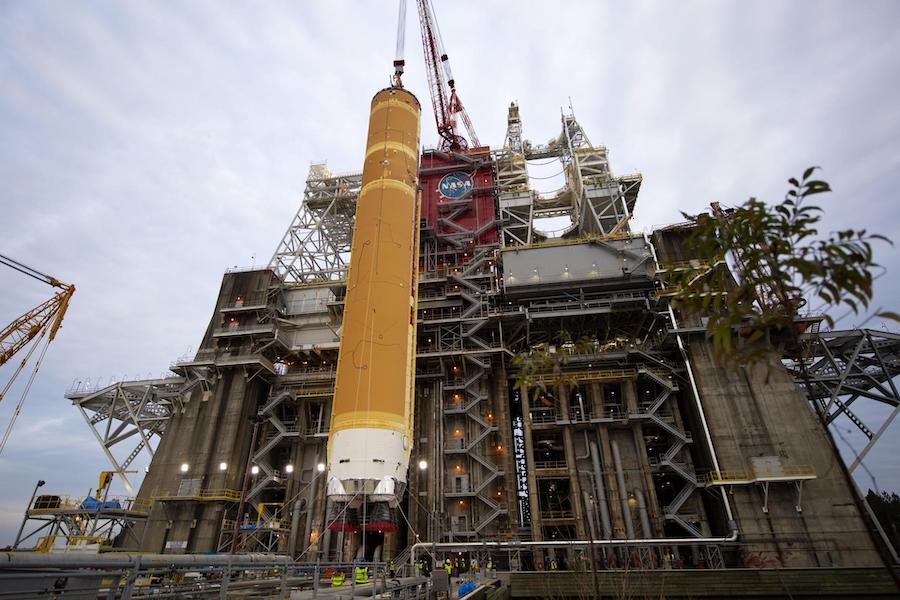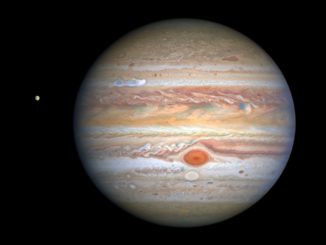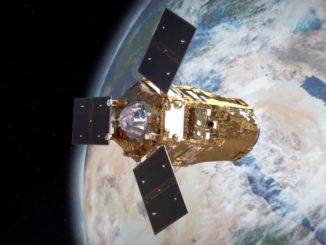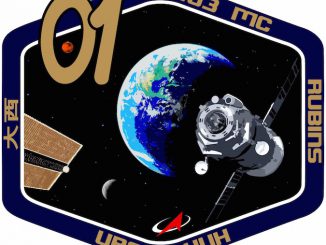
NASA officials released a nearly five-year, $28 billion plan Monday to return astronauts to the surface of the moon before the end of 2024, but the agency’s administrator said the “aggressive” timeline set by the Trump administration last year hinges on Congress approving $3.2 billion in the next few months to kick-start development of new human-rated lunar landers.
The plan unveiled Monday contained few new details not previously disclosed by NASA. It assumes crews will launch on NASA’s Space Launch System heavy-lift rocket, fly to the moon’s vicinity on an Orion capsule, then transfer into a commercially-developed lunar lander to ferry the astronauts to and from the lunar surface.
NASA released a new overview document Monday describing the agency’s approach to landing astronauts on the moon for the first time since the Apollo 17 mission in December 1972. The program, named Artemis, encompasses the SLS, Orion, Human Landing Systems, and the Gateway, a human-tended platform in lunar orbit that will eventually serve as a staging point for missions to the moon.
“NASA has all the key systems and contracts in place to ensure that we are meeting the president’s ambitious goal to return American astronauts to the moon for the first time since 1972,” said NASA Administrator Jim Bridenstine.
The Trump administration last year directed NASA to land the first woman and the next man on the moon by the end of 2024, moving up the space agency’s previous moon landing schedule by four years.
Bridenstine acknowledged the challenge of landing astronauts on the moon in four years. Three companies — Blue Origin, Dynetics and SpaceX — are developing human-rated lunar landers for NASA, which plans next year to select one or two of the lander teams to continue work on their spacecraft.
“There’s a number of different risks when you deal with human spaceflight,” Bridenstine said. “NASA is really really good at dealing with the technical risks.”
“The challenge that we have is the political risk — the programs that go too long, that cost too much, and that end up getting cast out later in the development program,” Bridenstine said, adding that programs that develop over longer schedules often end up with higher overall costs. “So to save money, and to reduce political risk, we want to go fast … 2024 is an aggressive timeline. Is it possible? Yes. Does everything have to go right? Yes.”

The Gateway is not required for the 2024 mission, which is designated Artemis 3. NASA decided earlier this year it would allow the companies developing human-rated lunar lander concepts to propose ways to transport astronauts from lunar orbit to the moon’s surface and back to the Orion spacecraft without using the Gateway, at least for the first landing on Artemis 3.
Bridenstine said Monday the Gateway is “critically important” for creating a “sustainable” lunar exploration program. It will allow lunar landers to be refueled and reused, and help NASA lead the establishment of a base camp on the moon, where engineers will develop the know-how to tap lunar resources like water ice to generate air, drinking water, and rocket fuel.
The Gateway will also have international contributions from Canada, Europe, and Japan.
The lessons learned will ultimately feed into planning a human expedition to Mars, according to NASA.
In the planning document released Monday, NASA outlined a two-step program to initially move fast to get astronauts to the moon by the end of 2024. Then NASA aims to develop an “Artemis Base Camp” by the end of the 2020s near the moon’s south pole, where crews will be able to live and work for months at a time.
The budget estimates in the planning document do not include developments focused on sustaining the lunar program, such as the Gateway station, surface habitats, and rovers.
That does not mean those programs will not be funded in the next year years, NASA said. The first two elements of the Gateway station remain scheduled to be launched together in 2023.
NASA projects the parts of the Artemis program required for the 2024 moon landing — known as Phase 1 — will cost $28 billion through fiscal year 2025, which begins Oct. 1, 2024.
That figure “represents the costs that are associated with the next four years in the Artemis program to land on the moon by 2024. so SLS funding, Orion funding, the Human Landing System, and of course the spacesuits, all of those things that are part of the Artemis program are included in that $28 billion.”
The Orion spacecraft has been in development since 2006 as part of NASA’s Constellation program initiated by the George W. Bush administration. After rising costs and delays, the Obama administration canceled the Constellation program in 2010, but the Orion spacecraft survived in NASA’s revamped deep space exploration program aimed at Mars.
The Space Launch System was announced in 2011 to loft the Orion spacecraft with crews on expeditions in deep space.
Both programs have suffered years of delays, but NASA says the first SLS/Orion test flight — named Artemis 1 — is scheduled for launch by November 2021. The first flight-ready SLS core stage will be test-fired in late October or early November at NASA’s Stennis Space Center in Mississippi, then delivered to the Kennedy Space Center for final assembly with its solid rocket boosters, cryogenic upper stage, and Orion spacecraft.
The segments of the SLS solid boosters, the rocket’s upper stage, and the Orion spacecraft have been completed and are awaiting arrival of the core stage before ground teams begin stacking the launcher inside the Vehicle Assembly Building at Kennedy.
The Artemis 1 mission will test out the Space Launch System and Orion spacecraft on a mission to orbit the moon and return to Earth. No astronauts will fly on Artemis 1.
“That mission will be over a month long, and it’ll be checking out all of the critical systems,” said Kathy Lueders, head of NASA’s human spaceflight directorate.

Assuming Artemis 1 goes according to plan, the next SLS/Orion launch in 2023 will carry a crew on a 10-day mission around the moon, sending people farther from Earth than ever before.
NASA recently decided to add a rendezvous and proximity operations demonstration to the Artemis 2 flight plan. The astronauts on Artemis 2 will take manual control of their Orion spaceship and pilot the capsule back toward the SLS upper stage after separating from the rocket in a high-altitude orbit around Earth, before setting off on a trajectory toward the moon.
The astronauts will “assess Orion’s handling characteristics” during the manual piloting demo, which will stop short of an actual docking with the upper stage,” NASA officials wrote in the Artemis planning document released Monday The demonstration will “provide provide performance data and operational experience that cannot be readily gained on the ground in preparation for critical rendezvous, proximity operations, docking, as well as undocking operations” beginning on the Artemis 3 mission.
After looping around the moon on a “free return trajectory,” the Artemis 2 astronauts will return to Earth and ride their Orion capsule to a parachute-assisted splashdown at sea.
That will set the stage for Artemis 3, which will use a similar SLS/Orion vehicle to launch the astronauts to rendezvous with a human-rated lander pre-positioned near the moon after launch aboard a commercial rocket. After flying the Orion spacecraft to link up with the lander in a high-altitude lunar orbit, the astronauts will move into the descent vehicle for the final leg of the journey to the moon.
NASA officials anticipate the Artemis 3 crew will spend nearly a week on the lunar surface to conduct at least two, and perhaps four, moonwalk excursions. Then the astronauts will take off and head back to the Orion spacecraft to ferry them back to Earth.
In parallel with the SLS, Orion, and lander test flights, NASA engineers will demonstrate an upgraded spacesuit design on the International Space Station before it is used by astronauts on the lunar surface.
Bridenstine said Monday that NASA could select a “cadre” of astronauts to begin training for Artemis missions, but the agency has no immediate plans to do so. He added that the agency typically assigns space crews about two years before launch.
The NASA chief also said Monday that the Artemis 3 mission’s landing site remains near the moon’s south pole. In a meeting of lunar scientists last week, Bridenstine discussed a hypothetical scenario in which the Artemis 3 astronauts could return to one of the Apollo landing sites in the moon’s equatorial regions if NASA defers plans for a polar landing
“Right now, we have no plans for Artemis 3 for anything other than the south pole,” Bridenstine said Monday.
Scientists have discovered evidence for water ice harbored in permanently shadowed craters near the moon’s south pole, but no mission has landed there yet. NASA plans to send robotic precursors to the south pole region in the next few years, including a rover named VIPER that will attempt to study the ice deposits up close.

The chances of achieving a lunar landing with astronauts in 2024 depend on winning support in Congress, and that support is not assured.
“The budget request that we have before the House and the Senate right now includes $3.2 billion for the Human Landing System,” Bridenstine said. “It is critically important that we get that $3.2 billion.”
A draft budget for NASA passed by the House in July would provide $628 million for lunar lander development in fiscal year 2021, which begins Oct. 1. The Senate has not drafted a NASA budget bill for the next fiscal year, and Congress is expected to pass a continuing resolution by the end of September to keep the government running through Election Day, after which lawmakers could pass a budget for the rest of fiscal year 2021.
The continuing resolution would fund government agencies at 2020 levels, and would not include money NASA says it needs for a Human Landing System.
“We need that $3.2 billion for the Human Landing System,” Bridenstine said. “I think that if we can have that done before Christmas, we’re still on track for a 2024 moon landing.”
If Congress passes a longer-term continuing resolution stretching into early next year, perhaps expiring in March, the longer wait for Human Landing System funds would make a 2024 moon landing more challenging, Bridenstine said. “I would argue that we’re still within the realm of possibility because we do have our work underway right now.”
“If we go beyond March and we still don’t have the Human Landing System funded, it becomes increasingly more difficult,” he said Monday in a conference call with reporters. “We want this to be a bipartisan effort, which we have had a lot of success in achieving. We would like to see the $3.2 billion for the Human Landing System funded at the earliest possible opportunity, and the best we can see that happening right now would be with an omnibus appropriations bill some time before the end of the year.”
More than $16 billion of the $28 billion NASA projects needing to make the Artemis 3 mission happen in 2024 will go toward developing a moon lander.
“If Congress doesn’t fund the moon landing program, then it won’t be achieved,” Bridenstine said later in his conference call with reporters Monday. “It’s really that simple. If they push the funding off, our goal would be to get to the moon at the earliest possible opportunity … If they keep delaying the funding, we will go to the moon at the earliest possible opportunity.”
Despite the funding uncertainty, Bridenstine said he is confident NASA will get the lunar lander money.
“I will tell you that there is broad consensus that it is time to go to the moon sustainably, and 2024 is achievable, and we’re working towards that,” he said. “When that omnibus appropriation is complete, I really believe there will be $3.2 billion for a Human Landing System. That could be at the end of the year, and it could be in March.”
Lueders said Monday that the lander teams led by Blue Origin, Dynetics and SpaceX are “hitting every single milestone” under contracts awarded by NASA in April. After advancing their designs and refining their plans, the teams will submit proposals to NASA again ahead of a decision by agency managers early next year on which lander concepts provide the best chance of achieving a crewed landing on the moon by the end of 2024.
NASA’s budget will be a key factor in determining whether the space agency has to pick one lunar lander team to go forward, or if NASA can afford to keep funding two concepts.
“We would really like to maintain competition,” Lueders said.
NASA has set up the HLS program as a public-private partnership, in which the government and companies share the cost of developing the landing vehicles.
Two of the lead contractors vying to build NASA’s first human-rated lunar lander in 50 years are Blue Origin and SpaceX, led by billionaires Jeff Bezos and Elon Musk. Bridenstine said companies could supply more private funding to make up for a potential shortfall in the NASA budget.
“We are getting our final proposals from the each of the (HLS) provides right now, and it would also be nice to look at different opportunities for different financing, and what that would mean for us,” Lueders said.
She said NASA officials will evaluate their options in the “February/March timeframe” of next year before finalizing the HLS procurement strategy.
SpaceX’s lander is a derivative of the Starship transportation system the company is privately developing. Blue Origin’s concept involves a descent element the company will build itself, along with a crew cabin from Lockheed Martin, and a propulsive transfer stage from Northrop Grumman.
“With a public-private partnership, the companies themselves could actually step up to the plate in a bigger way,” Bridenstine said. “That is something that needs to be seriously considered. Our goal is to create the plan that best optimizes our ability to land on the moon by 2024, but certainly if the money doesn’t materialize, could they do it with their own resources? I’ll leave it to them to make their own determination.”
Email the author.
Follow Stephen Clark on Twitter: @StephenClark1.



